翻译中英对照
- 格式:doc
- 大小:47.00 KB
- 文档页数:3
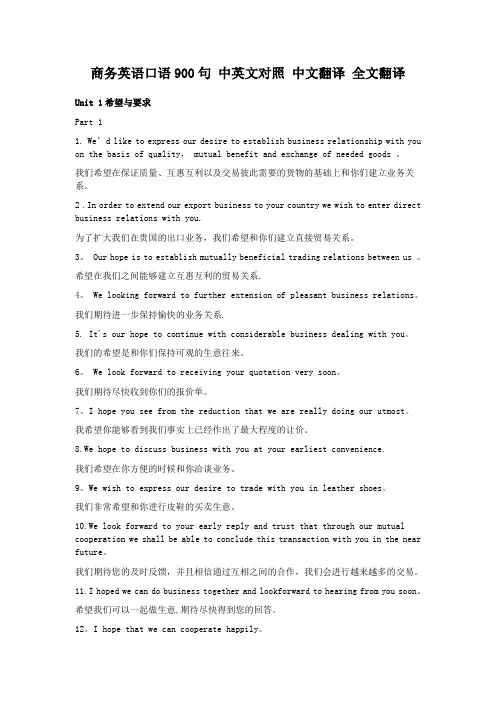
商务英语口语900句中英文对照中文翻译全文翻译Unit 1希望与要求Part 11. We’d like to express our desire to establish business relationship with you on the basis of quality, mutual benefit and exchange of needed goods 。
我们希望在保证质量、互惠互利以及交易彼此需要的货物的基础上和你们建立业务关系。
2 .In order to extend our export business to your country we wish to enter direct business relations with you.为了扩大我们在贵国的出口业务,我们希望和你们建立直接贸易关系。
3。
Our hope is to establish mutually beneficial trading relations between us 。
希望在我们之间能够建立互惠互利的贸易关系.4。
We looking forward to further extension of pleasant business relations。
我们期待进一步保持愉快的业务关系.5. It's our hope to continue with considerable business dealing with you。
我们的希望是和你们保持可观的生意往来。
6。
We look forward to receiving your quotation very soon。
我们期待尽快收到你们的报价单。
7。
I hope you see from the reduction that we are really doing our utmost。
我希望你能够看到我们事实上已经作出了最大程度的让价。
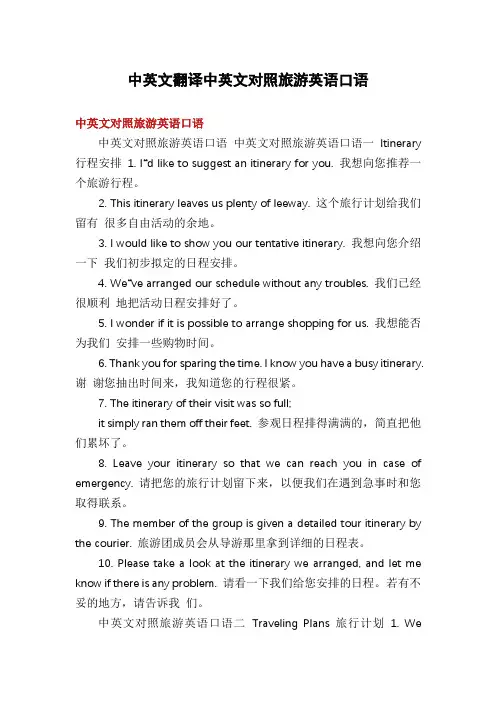
中英文翻译中英文对照旅游英语口语中英文对照旅游英语口语中英文对照旅游英语口语中英文对照旅游英语口语一Itinerary 行程安排1. I“d like to suggest an itinerary for you. 我想向您推荐一个旅游行程。
2. This itinerary leaves us plenty of leeway. 这个旅行计划给我们留有很多自由活动的余地。
3. I would like to show you our tentative itinerary. 我想向您介绍一下我们初步拟定的日程安排。
4. We“ve arranged our schedule without any troubles. 我们已经很顺利地把活动日程安排好了。
5. I wonder if it is possible to arrange shopping for us. 我想能否为我们安排一些购物时间。
6. Thank you for sparing the time. I know you have a busy itinerary. 谢谢您抽出时间来,我知道您的行程很紧。
7. The itinerary of their visit was so full;it simply ran them off their feet. 参观日程排得满满的,简直把他们累坏了。
8. Leave your itinerary so that we can reach you in case of emergency. 请把您的旅行计划留下来,以便我们在遇到急事时和您取得联系。
9. The member of the group is given a detailed tour itinerary by the courier. 旅游团成员会从导游那里拿到详细的日程表。
10. Please take a look at the itinerary we arranged, and let me know if there is any problem. 请看一下我们给您安排的日程。
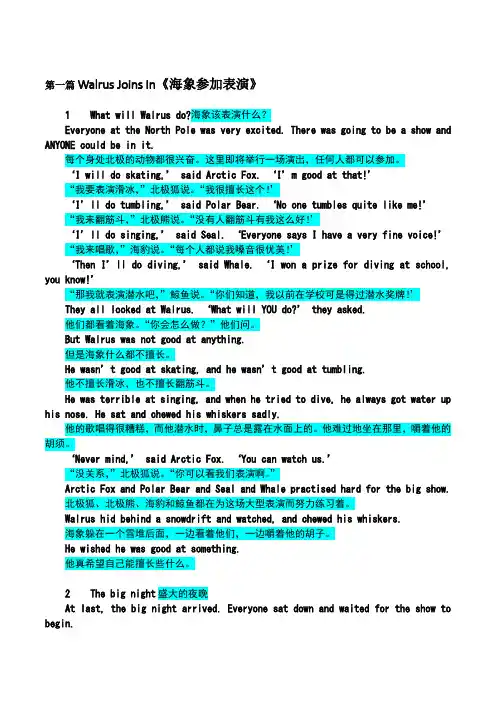
第一篇Walrus Joins In《海象参加表演》1What will Walrus do?海象该表演什么?Everyone at the North Pole was very excited. There was going to be a show and ANYONE could be in it.每个身处北极的动物都很兴奋。
这里即将举行一场演出,任何人都可以参加。
‘I will do skating,’ said Arctic Fox. ‘I’m good at that!’“我要表演滑冰,”北极狐说。
“我很擅长这个!’‘I’ll do tumbling,’ said Polar Bear. ‘No one tumbles quite like me!’“我来翻筋斗,”北极熊说。
“没有人翻筋斗有我这么好!’‘I’ll do singing,’ said Seal. ‘Everyone says I have a very fine voice!’“我来唱歌,”海豹说。
“每个人都说我嗓音很优美!’‘Then I’ll do diving,’ said Whale. ‘I won a prize for diving at school, you know!’“那我就表演潜水吧,”鲸鱼说。
“你们知道,我以前在学校可是得过潜水奖牌!’They all looked at Walrus. ‘What will YOU do?’ they asked.他们都看着海象。
“你会怎么做?”他们问。
But Walrus was not good at anything.但是海象什么都不擅长。
He wasn’t good at skating, and he wasn’t good at tumbling.他不擅长滑冰,也不擅长翻筋斗。
He was terrible at singing, and when he tried to dive, he always got water up his nose. He sat and chewed his whiskers sadly.他的歌唱得很糟糕,而他潜水时,鼻子总是露在水面上的。
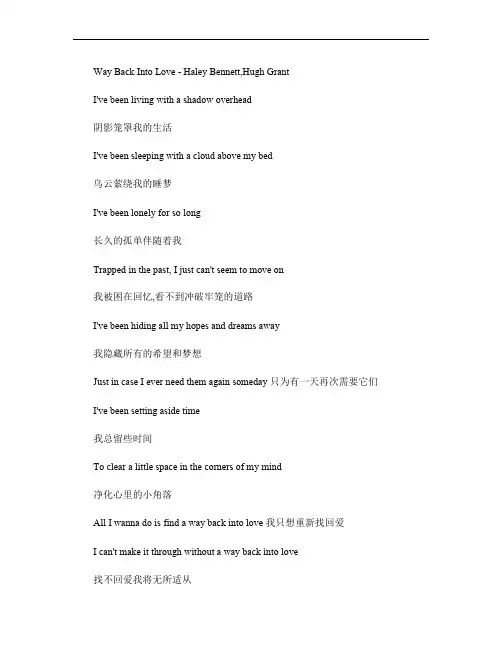
Way Back Into Love - Haley Bennett,Hugh GrantI've been living with a shadow overhead阴影笼罩我的生活I've been sleeping with a cloud above my bed乌云萦绕我的睡梦I've been lonely for so long长久的孤单伴随着我Trapped in the past, I just can't seem to move on我被困在回忆,看不到冲破牢笼的道路I've been hiding all my hopes and dreams away我隐藏所有的希望和梦想Just in case I ever need them again someday 只为有一天再次需要它们I've been setting aside time我总留些时间To clear a little space in the corners of my mind净化心里的小角落All I wanna do is find a way back into love 我只想重新找回爱I can't make it through without a way back into love找不回爱我将无所适从I've been watching but the stars refuse to shine我留心观察,然而繁星不愿发亮I've been searching but I just don't see the signs我一直搜寻,但看不到任何征兆I know that it's out there我知道它就在那里There's gonna be something for my soul somewhere一定有个为我灵魂而生的东西在某处I've been looking for someone to shed some light我一直在寻找着让我发光的人Not somebody just to get me through the night而非只是个陪我过夜的家伙I could use some direction我愿你明白And I'm open to your suggestions我的心房为你而开All I wanna do is find a way back into love 我只要重新找回爱I can't make it through without a way back into love找不回爱我将无所适从And if I open my heart again若我再次敞开心扉I guess I'm hoping you'll be there for me in the end我想我期望能在那里陪我到最后的人是你There are moments when I don't know if it's real有些时刻我会怀疑那是否真实Or if anybody feels the way I feel或者是否有人和我有同样的感觉I need inspiration我要的是灵感Not just another negotiation不是又一次的妥协All I wanna do is find a way back into love 我只要重新找回爱I can't make it through without a way back into love找不回爱我将无所适从And if I open my heart to you如果我对你敞开心扉I'm hoping you'll show me what to do我希望你告诉我该怎么做And if you help me to start again如果你能帮我重新开始You know that I'll be there for you in the end你知道我会在最后那里等你Take Me to Your Heart - Michael Learns To Rock hiding from the rain and snow藏身于雨雪之中trying to forget but i won't let go努力忘记,但我怎能就这样离去looking at a crowded street看着熙熙攘攘的街道listening to my own heart beat却只能听见自己的心跳so many people这么多的人all around the world在世界上tell me where do i find请告诉我在哪里可以找到someone like you girl像你一样的女孩take me to your heart将我留存心间take me to your soul与你的灵魂相伴give me your hand before i'm old 给我你的手,在我老去之前show me what love is问情为何物- haven't got a clue在我们彼此离开前show me that wonders can be true 问奇迹上演they say nothing lasts forever他们说没有什么可以天长地久we're only here today我们也能此时相守love is now or never现在或者永不回头bring me far away请带我一起远走take me to your heart请爱我吧take me to your soul与你的灵魂相伴give me your hand and hold me给我你的手拥我入怀show me what love is问情为何物- be my guiding star让星辰照亮我路it's easy take me to your heart其实爱我真的很简单standing on a mountain high站在高山之颠looking at the moon through a clear blue sky 看着月亮高挂于清澈的蓝天i should go and see some friends也许我应该去和朋友们在一起but they don't really comprehend但他们真的不明白我此时的心情don't need too much talking不需要繁琐的言语without saying anything甚至可以一语不发all i need is someone我仅仅需要who makes me wanna sing一个能让我欢乐而歌的人A step you can’t take back - keiraknightley So you find yourself at this subway 你发现自己在地铁里When your world in a bag by your side当你的世界在包装下随身携带And all at once it seemed like a good way一切似乎看起来很完美You realized its the end of your life你意识到这就是你生命的终结For what it's worth意义也就如此Here comes the train upon the track火车在轨道上奔驰而来And there goes the pain it cuts to black 带走伤痛只剩下一片黑Are you ready for the last act?最后的行动你准备好了吗To take a step you can't take back踏上永不回头的征程Take in all the punches you could take 承受所有你能承受的逆境Took 'em all right on your chest把一切放进心里Now the countless back is breaking此刻无数次的回头打破这一切Again, again再一次再一次For what it's worth意义也就如此Here comes the train upon the track火车在轨道上奔驰而来And there goes the pain it cuts to black带走伤痛只剩下一片黑Are you ready for the last act?最后的行动你准备好了吗To take a step you can't take back踏上永不回头的征程Did she love you?她爱你吗Did she take you down?她带给你伤痛吗Was she on her knees when she kissed your crown?在亲吻你的王冠时她有没有双膝跪地Tell me what you found 告诉我你所知道的Here comes the rain, so hold your hat大雨不期而至抓紧你的帽子And don't pray to God, cause He won't talk back不要祈祷上帝因为他不会跟你对讲Are you ready for the last act?最后的行动你准备好了吗To take a step you can't take back踏上永不回头的征程Back, back, back不回头不回头不回头You can't take back你不会回头Back, back, back不回头不回头不回头So you find yourself at this subway你发现自己在地铁里When your world in a bag by your side 当你的世界在包装下随身携带Boom Clap - Charli XCXBoom BoomBoom Clap我的心跳像雷动的掌声You're picture perfect blue你是画面里最完美的蓝色Sunbathing on the moon如同在月球上晒日光浴Stars shining as your bones illuminate群星闪耀就像你的耀眼的身影First kiss just like a drug初吻就像毒药Under your influence就无法自拔You take me over you're the magic in my veins血液里灌透着你的魔力,颠覆我的生命This must be love那一定是爱Boom Clap震耳欲聋The sound of my heart是我的心跳声The beat goes on and on and on and on and 这节奏跟上跟上跟上Boom Clap震耳欲聋You make me feel good这感觉真好Come on to me come on to me now爱上我,爱上我Boom Clap震耳欲聋The sound of my heart是我的心跳声The beat goes on and on and on and on and 这节奏跟上跟上跟上Boom Clap震耳欲聋You make me feel good这感觉真好Come on to me come on to me now到我的身边来No silver or no gold无需金银Could dress me up so good就可以给我好好打扮一下You're the glitter in the darkness of my world你是我生命黑暗中的曙光Just tell me what to do说你要我做什么I'll fall right into you我就会沦陷于你Going under cast a spell just say the word一个咒语就可以施一个法术I feel your love你爱我Boom Clap震耳欲聋The sound of my heart是我的心跳声The beat goes on and on and on and on and 这节奏跟上跟上跟上Boom Clap震耳欲聋You make me feel good这感觉真好Come on to me come on to me now爱上我,爱上我Boom Clap震耳欲聋The sound of my heart是我的心跳声The beat goes on and on and on and on and 这节奏跟上跟上跟上Boom Clap震耳欲聋You make me feel good这感觉真好Come on to me come on to me now到我身边来You are the light and I will follow你是我要追随的光You let me lose my shadow让我失去影子You are the sun the glowing halo你是太阳,有着耀眼的光环And you keep burning me up with all ofyour love然后用你的爱把我燃烧Boom Clap震耳欲聋The sound of my heart是我的心跳声The beat goes on and on and on and on and 这节奏跟上跟上跟上Boom Clap震耳欲聋You make me feel good这感觉真好Come on to me come on to me now爱上我Boom Clap震耳欲聋The sound of my heart是我的心跳声The beat goes on and on and on and on and 这节奏跟上跟上跟上Boom Clap震耳欲聋You make me feel good这感觉真好Come on to me come on to me now到我身边来Boom Clap震耳欲聋The sound of my heart是我的心跳声The beat goes on and on and on and on and 这感觉跟上跟上跟上Boom Clap震耳欲聋You make me feel good这感觉真好Come on to me come on to me now爱上我,爱上我Boom Clap震耳欲聋The sound of my heart是我的心跳声The beat goes on and on and on and on and 这节奏跟上跟上跟上Boom Clap震耳欲聋You make me feel good这感觉真好Come on to me come on to me now 快来到我身边吧That's Why (You Go Away (1999 Digital Remaster - Michael Learns To Rock That's why you go那是为何(你走了Baby won't you tell me why?宝贝不要告诉我为什么There is sadness in your eyes.你的眼底写着悲咽I don't wanna say goodbey to you.我不想就此与你告别Love is one big illusion!爱是一场幻灭l should try to forget.我该尽力将其忘却But there is something left in my head.但我的心中总留存着一种感觉You're the one who set it up.是你带给我这种感觉Now you're the one to make it stop.又是你将它浇灭I'm the one who's feeling lost right now. 现在我的心早已迷失方向Now you want me to forget.现在你要我忘却Every little thing you said.你所说的一切But there is something left in my head. 但我心中总留存着一种感觉I won't forget the way you're kissing.我忘不了你亲吻的热烈The felling's so strong这深挚的情感were lasting for so long!将绵绵不绝But l'm not the man Ur heart is missing!但我却不是你心中想念的男人That's why you go away I know!那正是为何你不辞而别You were never satisfied.我知道无论我怎样努力No matter how l tried.也无法使你满意Now you wanna say goodbye to me.现在你要向我告别Love is one big illusion! 爱是一场幻灭I should try to forget!我该尽力将其忘却But there is something left in my head!但我心中总留存着一种感觉I won't forget the way you're kissing!我忘不了你亲吻的热烈The felling's so strong!这深挚的情感were lasting for so long!将绵绵不绝But l'm not the man Ur heart is missing!但我却不是你心中想念的男人That's why you go away I know!那正是为何你不辞而别Yes l know !是的,我知道Sitting here all alone.孤独的坐在这In the middle of nowhere.不知身在何处Don't know which way to go.不知该何去何从There airn't so much 2 say now between us.你我已相对无言There ain't so much for you.你不再意味着什么There ain't so much for me anymore.对你我已冷却了心情对我你也有同感I won't forget the way you're kissing!我忘不了你亲吻的热烈The feeling's so strong.这深挚的情感were lasting for so long!将绵绵不绝But l'm not the man Ur heart is missing!但我却不是你心中想念的男人That's why you go away I know!那正是为何你不辞而别That's why you go away I know!那正是为何你不辞而别She - Groove CoverageShe hangs out every day near by the beach 她每天躺在海滩边的吊床上. Havin’ a HEINEKEN fallin’ asleep喝杯海涅肯啤酒便入睡She looks so sexy when she’s walking the sand漫步在沙滩上的她看上去如此性感Nobody ever put a ring on her hand 她也不接受任何人的戒指海边游泳海边捕鱼She is the story the story is she她就是传说传说就是她She sings to the moon and the stars in the sky她向天上的月亮和星星唱歌Shi ning from high above you shouldn’t ask why那样高高闪耀着你又怎么知道为什么She is the one that you never forget 见过她你便永远不能忘记She is the heaven-sent angel you met见过她你便知道她是天使Oh, she must be the reason why God made a girl噢,她就是上帝制造女孩的原因She is so pretty all over the world即使走遍全世界她也是如此的美丽She puts the rhythm, the beat in the drum她哼着小曲打着圆鼓She comes in the morning and the evening she’s gone早上出现晚上就不见Every little hour every second you live你活着的每分每秒Trust in eternity that’s what she giv es都相信永恒因为都是她带来的She looks like Marilyn, walks like Suzanne 她看上去像Marilyn,走路又像Suzanne She talks like Monica and Marianne她说话则像Monica 和MarianneShe wins in everything that she might do只要她愿意她可以得到一切And she will respect you forever just you 但她永远都尊重你只是因为是你She is the one that you never forget见过她你便永远不能忘记She is the heaven-sent angel you met见过她你便知道她是天使Oh, she must be the reason why God made a girl噢,她就是上帝制造女孩的原因She is so pretty all over the world即使走遍全世界她也是如此的美丽She is so pretty all over the world即使走遍全世界她也是如此的美丽She is so pretty她如此的美丽She is like you and me她就像你和我Like them like we像他们像我们She is in you and me她就在你我中间She is the one that you never forget见过她你便永远不能忘记She is the heaven-sent angel you met见过她你便知道她是天使Oh, she must be the reason why God made a girl噢,她就是上帝制造女孩的原因She is so pretty all over the world即使走遍全世界她也是如此的美丽(She is the one She is the one 她就是(That you never forget That you never forget你永远都不会忘记She is the heaven-sent angel you met见过她你便知道她是天使She’s the reason (oh she must be the reason why God made a girl 噢,她就是上帝制造女孩的原因She is so pretty all over the world (oh...即使走遍全世界她也是如此的美丽Na nananana ….Lemon Tree - Fools GardenI'm sitting here in the boring room.我在房间里无聊地坐着。
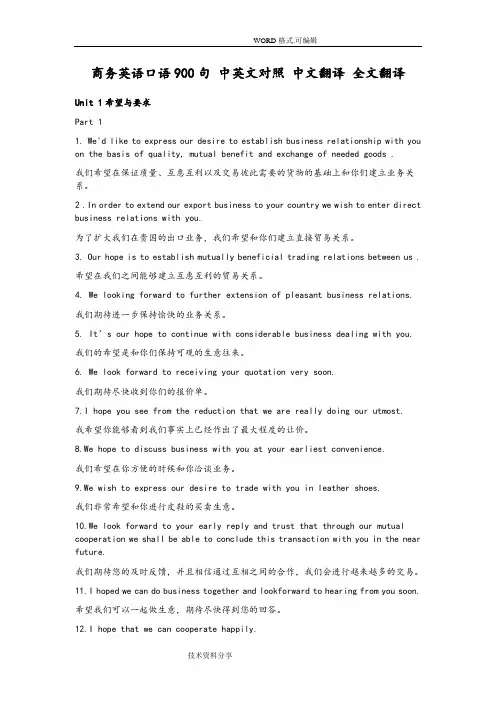
商务英语口语900句中英文对照中文翻译全文翻译Unit 1希望与要求Part 11. We'd like to express our desire to establish business relationship with you on the basis of quality, mutual benefit and exchange of needed goods .我们希望在保证质量、互惠互利以及交易彼此需要的货物的基础上和你们建立业务关系。
2 .In order to extend our export business to your country we wish to enter direct business relations with you.为了扩大我们在贵国的出口业务,我们希望和你们建立直接贸易关系。
3. Our hope is to establish mutually beneficial trading relations between us .希望在我们之间能够建立互惠互利的贸易关系。
4. We looking forward to further extension of pleasant business relations.我们期待进一步保持愉快的业务关系。
5. It’s our hope to continue with considerable business dealing with you.我们的希望是和你们保持可观的生意往来。
6. We look forward to receiving your quotation very soon.我们期待尽快收到你们的报价单。
7.I hope you see from the reduction that we are really doing our utmost.我希望你能够看到我们事实上已经作出了最大程度的让价。
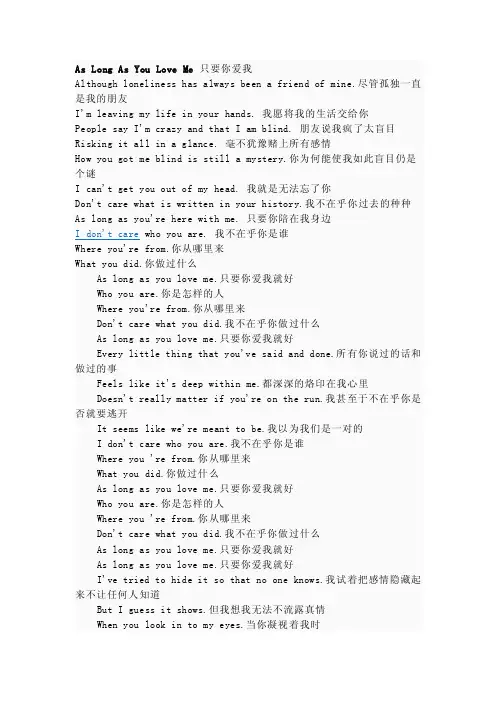
As Long As You Love Me只要你爱我Although loneliness has always been a friend of mine.尽管孤独一直是我的朋友I'm leaving my life in your hands. 我愿将我的生活交给你People say I'm crazy and that I am blind. 朋友说我疯了太盲目Risking it all in a glance. 毫不犹豫赌上所有感情How you got me blind is still a mystery.你为何能使我如此盲目仍是个谜I can't get you out of my head. 我就是无法忘了你Don't care what is written in your history.我不在乎你过去的种种As long as you're here with me. 只要你陪在我身边I don't care who you are. 我不在乎你是谁Where you're from.你从哪里来What you did.你做过什么As long as you love me.只要你爱我就好Who you are.你是怎样的人Where you're from.你从哪里来Don't care what you did.我不在乎你做过什么As long as you love me.只要你爱我就好Every little thing that you've said and done.所有你说过的话和做过的事Feels like it's deep within me.都深深的烙印在我心里Doesn't really matter if you're on the run.我甚至于不在乎你是否就要逃开It seems like we're meant to be.我以为我们是一对的I don't care who you are.我不在乎你是谁Where you 're from.你从哪里来What you did.你做过什么As long as you love me.只要你爱我就好Who you are.你是怎样的人Where you 're from.你从哪里来Don't care what you did.我不在乎你做过什么As long as you love me.只要你爱我就好As long as you love me.只要你爱我就好I've tried to hide it so that no one knows.我试着把感情隐藏起来不让任何人知道But I guess it shows.但我想我无法不流露真情When you look in to my eyes.当你凝视着我时What you did and where you're coming from.你做过什么从哪里来I don't care As long as you love me,baby.我不在乎,只要你爱我就好,宝贝I don't care who you are.我不在乎你是谁Where you're from.你从哪里来What you did.你做过什么As long as you love me.只要你爱我就好Who you are.你是谁Where you're from.你从哪里来Don't care what you did.我不在乎你做过什么As long as you love me.只要你爱我就好Who you are.你是谁Where you're from.你从哪里来What you did.你做过什么As long as you love me.只要你爱我就好Who you are.你是谁Where you're from.你从哪里来As long as you love me.只要你爱我就好Who you are.你是谁As long as you love me.只要你爱我就好What you did.你做过什么I don't care.我不在乎As long as you love me.只要你爱我就好我把爱给了你歌词是:just a smile and the rain is gone 你用仅仅一个微笑,让雨天放晴。
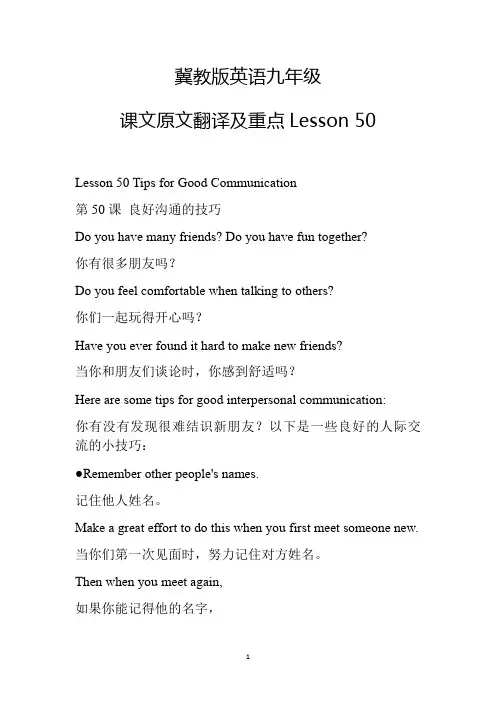
冀教版英语九年级课文原文翻译及重点Lesson 50Lesson 50 Tips for Good Communication第50课良好沟通的技巧Do you have many friends? Do you have fun together?你有很多朋友吗?Do you feel comfortable when talking to others?你们一起玩得开心吗?Have you ever found it hard to make new friends?当你和朋友们谈论时,你感到舒适吗?Here are some tips for good interpersonal communication:你有没有发现很难结识新朋友?以下是一些良好的人际交流的小技巧:●Remember other people's names.记住他人姓名。
Make a great effort to do this when you first meet someone new.当你们第一次见面时,努力记住对方姓名。
Then when you meet again,如果你能记得他的名字,you will easily make that person feel comfortable if you remember his or her name.当你们再相遇时,就很容易让对方感觉舒服。
It shows you care.这表明你在意对方。
●Smile. Make sure you smile and greet others in a friendly way,微笑。
务必友好地微笑着问候对方。
especially the first time you meet them.尤其是第一次见到对方时。
Smiling can be a passport to good communication.微笑是良好沟通的通行证。
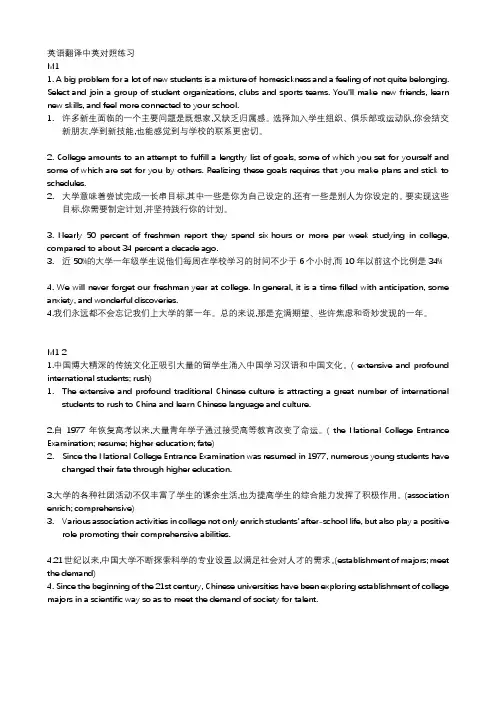
英语翻译中英对照练习M11. A big problem for a lot of new students is a mixture of homesickness and a feeling of not quite belonging. Select and join a group of student organizations, clubs and sports teams. You'll make new friends, learn new skills, and feel more connected to your school.1.许多新生面临的一个主要问题是既想家,又缺乏归属感。
选择加入学生组织、俱乐部或运动队,你会结交新朋友,学到新技能,也能感觉到与学校的联系更密切。
2. College amounts to an attempt to fulfill a lengthy list of goals, some of which you set for yourself and some of which are set for you by others. Realizing these goals requires that you make plans and stick to schedules.2.大学意味着尝试完成一长串目标,其中一些是你为自己设定的,还有一些是别人为你设定的。
要实现这些目标,你需要制定计划,并坚持践行你的计划。
3. Nearly 50 percent of freshmen report they spend six hours or more per week studying in college, compared to about 34 percent a decade ago.3.近50%的大学一年级学生说他们每周在学校学习的时间不少于6个小时,而10年以前这个比例是34%4. We will never forget our freshman year at college. In general, it is a time filled with anticipation, some anxiety, and wonderful discoveries.4.我们永远都不会忘记我们上大学的第一年。
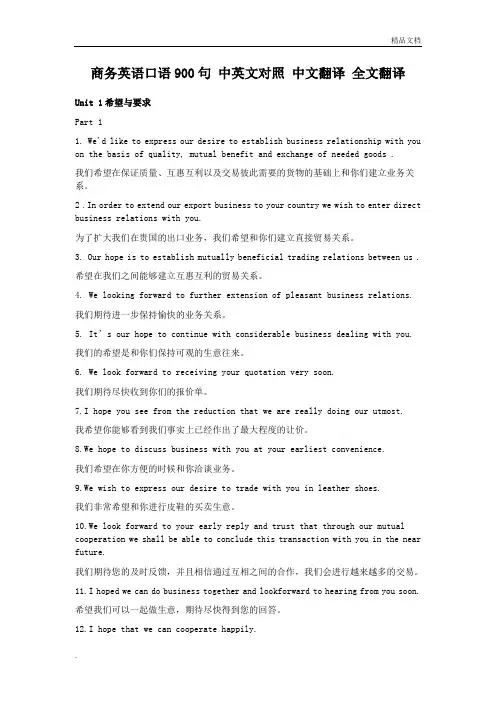
商务英语口语900句中英文对照中文翻译全文翻译Unit 1希望与要求Part 11. We'd like to express our desire to establish business relationship with you on the basis of quality, mutual benefit and exchange of needed goods .我们希望在保证质量、互惠互利以及交易彼此需要的货物的基础上和你们建立业务关系。
2 .In order to extend our export business to your country we wish to enter direct business relations with you.为了扩大我们在贵国的出口业务,我们希望和你们建立直接贸易关系。
3. Our hope is to establish mutually beneficial trading relations between us .希望在我们之间能够建立互惠互利的贸易关系。
4. We looking forward to further extension of pleasant business relations.我们期待进一步保持愉快的业务关系。
5. It’s our hope to continue with considerable business dealing with you.我们的希望是和你们保持可观的生意往来。
6. We look forward to receiving your quotation very soon.我们期待尽快收到你们的报价单。
7.I hope you see from the reduction that we are really doing our utmost.我希望你能够看到我们事实上已经作出了最大程度的让价。
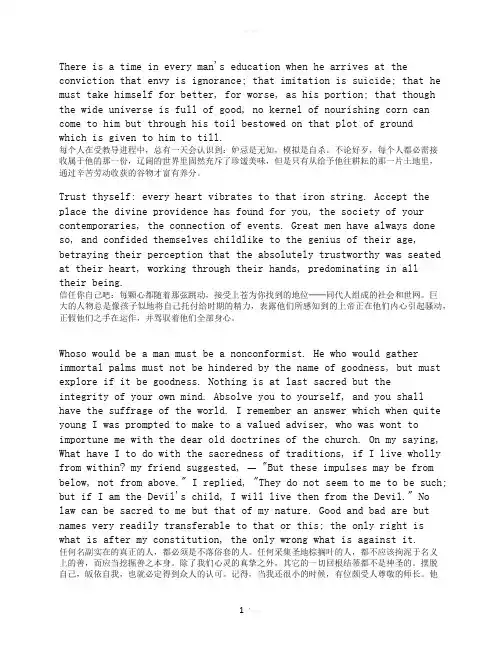
There is a time in every man's education when he arrives at the conviction that envy is ignorance; that imitation is suicide; that he must take himself for better, for worse, as his portion; that though the wide universe is full of good, no kernel of nourishing corn can come to him but through his toil bestowed on that plot of groundwhich is given to him to till.每个人在受教导进程中,总有一天会认识到:妒忌是无知,模拟是自杀。
不论好歹,每个人都必需接收属于他的那一份,辽阔的世界里固然充斥了珍馐美味,但是只有从给予他往耕耘的那一片土地里,通过辛苦劳动收获的谷物才富有养分。
Trust thyself: every heart vibrates to that iron string. Accept the place the divine providence has found for you, the society of your contemporaries, the connection of events. Great men have always done so, and confided themselves childlike to the genius of their age, betraying their perception that the absolutely trustworthy was seated at their heart, working through their hands, predominating in alltheir being.信任你自己吧:每颗心都随着那弦跳动,接受上苍为你找到的地位──同代人组成的社会和世网。
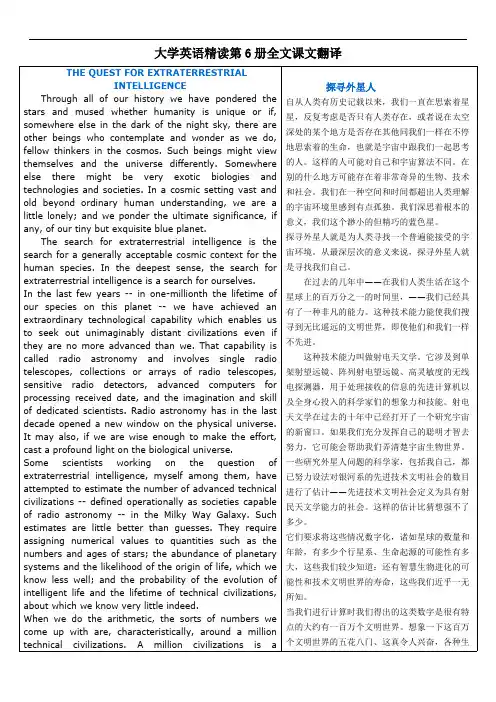
大学英语精读第6册全文课文翻译THE QUEST FOR EXTRATERRESTRIALINTELLIGENCEThrough all of our history we have pondered the stars and mused whether humanity is unique or if, somewhere else in the dark of the night sky, there are other beings who contemplate and wonder as we do, fellow thinkers in the cosmos. Such beings might view themselves and the universe differently. Somewhere else there might be very exotic biologies and technologies and societies. In a cosmic setting vast and old beyond ordinary human understanding, we are a little lonely; and we ponder the ultimate significance, if any, of our tiny but exquisite blue planet.The search for extraterrestrial intelligence is the search for a generally acceptable cosmic context for the human species. In the deepest sense, the search for extraterrestrial intelligence is a search for ourselves.In the last few years -- in one-millionth the lifetime of our species on this planet -- we have achieved an extraordinary technological capability which enables us to seek out unimaginably distant civilizations even if they are no more advanced than we. That capability is called radio astronomy and involves single radio telescopes, collections or arrays of radio telescopes, sensitive radio detectors, advanced computers for processing received date, and the imagination and skill of dedicated scientists. Radio astronomy has in the last decade opened a new window on the physical universe. It may also, if we are wise enough to make the effort, cast a profound light on the biological universe.Some scientists working on the question of extraterrestrial intelligence, myself among them, have attempted to estimate the number of advanced technical civilizations -- defined operationally as societies capable of radio astronomy -- in the Milky Way Galaxy. Such estimates are little better than guesses. They require assigning numerical values to quantities such as the numbers and ages of stars; the abundance of planetary systems and the likelihood of the origin of life, which we know less well; and the probability of the evolution of intelligent life and the lifetime of technical civilizations, about which we know very little indeed.When we do the arithmetic, the sorts of numbers we come up with are, characteristically, around a million technical civilizations. A million civilizations is a探寻外星人自从人类有历史记载以来,我们一直在思索着星星,反复考虑是否只有人类存在,或者说在太空深处的某个地方是否存在其他同我们一样在不停地思索着的生命,也就是宇宙中跟我们一起思考的人。
1. Electrical Measuring Instruments电子测量仪表Electrical personnel use many different types of measuring instruments. 电子技术人员使用许多不同类型的测量仪器。
Some jobs require very accurate measurements while other jobs need only rough estimates. 一些工作需要精确测量面另一些工作只需粗略估计。
Some instruments are used solely to determine whether or not a circuit is complete. 有些仪器被使用仅仅是确定线路是否完整。
The most common measuring and testing instruments are voltage testers, voltmeters, ammeters, ohmmeters, continuity testers, megohmmeters, wattmeters(功率计), and watt-hour meters(电度表,电表)。
最常用的测量测试仪表有:电压测试仪,电压表,欧姆表,连续性测试仪,兆欧表,瓦特表还有瓦特小时表。
All meters used for measuring electrical values are basically current meters. 所有测量电值的表基本上都是电流表。
They measure or compare the values of current flowing through them. 他们测量或是比较通过他们的电流值。
The meters are calibrated and the scale is designed to read the value of the desired unit. 这些仪表可以被校准并且设计了不同的量程,以便读出期望的数值。
How long will the Expo last? The Expo will last for six months. 世博会持续多久?世博会将持续半年。
A typical dinner for a table of eight people consists of four courses of cold dishes, four courses of hot dishes, coupled with soup and steamed rice. 8人一桌的标准晚餐含4道冷盘、4道热炒,外加汤和米饭。
解读学好英语的18条黄金法则:The three essential factors are “color, aroma and taste.”中餐的三大要素,即“色、香、味”。
You can go there through tunnels under the river.你可以走过江隧道。
How far is the airport from the Expo Village? About an hour by bus.机场到世博村有多远?乘公交车大概一个小时。
.Where shall we wait for the on-site bus? Over there. Please look for the road sign.我们应该在哪里等园内巴士?在那里。
请注意看路标。
Are you all volunteers for the Expo? Yes, we are. We want to do something for our city and the Expo.你们都是世博会的志愿者吗?是的,我们希望为自己的城市和世博会做些事。
Can I help you? Yes, please. I’m looking for the Service Center.需要我帮助吗?是的,请问服务中心在哪里?An old Chinese saying goes like “Food is the paramount necessity of the people.”中国有一句古话叫做“民以食为天”。
TheLittle Prince[法] Antoine deSaint-Exupery圣埃克苏佩里This magical musical fable begins as a pilot makes a forced landing on the barren Sahara Desert. He is befriended by a "little" prince from the other planet. The Prince was in love with his flower, a vain rose, who complained about her conditions, knowing the Little Prince would attend to her every desire. Eventually, the Little Prince leaves his planet because of his inability to confront the flower.In the days that follow, the pilot learns of the small boy's history and planet-hopping journeys in which he met a King, a businessman, the drunk,an historian, and a general… It isn't until he comes to Earth that the Little Prince learnsthe secrets of the importance of life from a Fox."My life is very monotonous," the fox said. "I hunt chickens; men hunt me. All the chickens are just alike, and all the men are just alike. And, in consequence, I am a little bored. But if you tame me, it will be as if the sun came to shine on my life . I shall know the sound of a step that will be different from all the others. Other steps send me hurrying back underneath the ground. Yours will call me, like music, out of my burrow. And then look: you see the grain-fields down yonder? I do not eat bread. Wheat is of no use to me. The wheat fields have nothing to say to me. And that is sad. But you have hair that is the colour of gold. Think how wonderful that will be when you have tamed me! The grain, whichis also golden, will bring me back the thought of you. And I shall love to listen to the wind in the wheat..."The fox gazed at the little prince, for a long time."Please-- tame me!" he said."I want to, very much," the little prince replied. "But I have not much time. I have friends to discover, and a great many things to understand.""One only understands the things that one tames," said the fox. "Men have no more time to understand anything. They buy things all ready made at the shops. But there is no shop anywhere where one can buy friendship, and so men have no friends any more. If you want a friend, tame me...""What must I do, to tame you?" asked the little prince."You must be very patient," replied the fox. "First you will sit down at a little distance from me-- like that-- in the grass. I shall look at you out of the corner of my eye, and you will say nothing. Words are the source of misunderstandings. But yo u will sit a little closer to me, every day..."The next day the little prince came back."It would have been better to come back at the same hour," said the fox. "If, for example, you come at four o'clock in the afternoon, then at three o'clock I shall begin to be happy. I shall feel happier and happier as the hour advances. At four o'clock, I shall already be worrying and jumping about. I shall show you how happy I am! But if you come at just any time, I shall never know at what hour my heart is to be ready to greet you... One must observe the proper rites..."So the little prince tamed the fox. And when the hour of his departure drew near--"Ah," said the fox, "I shall cry.""It is your own fault," said the little prince. "I never wished you any sort of harm; but you wanted me to tame you...""Yes, that is so," said the fox."But now you are going to cry!" said the little prince."Yes, that is so," said the fox."Then it has done you no good at all!""It has done me good," said the fox, "because of the color of the wheat fields." And then he added:"Go and look again at the roses. You will understand now that yours is unique in all the world. Then come back to saygoodbye to me, and I will make you a present of a secret."The little prince went away, to look again at the roses."You are not at all like my rose," he said. "As yet you are nothing. No one has tamed you, and you have tamed no one. You are like my fox when I first knew him. He was only a fox like a hundred thousand other foxes. But I have made him my friend, and now he is unique in all the world."And the roses were very much embarrassed."You are beautiful, but you are empty," he went on. "One could not die for you. To be sure, an ordinary passerby would think that my rose looked just like you-- the rose that belongs to me. But in herself alone she is more important than all the hundreds of you other roses:because it is she that I have watered; because it is she that I have put under the glass globe; because it is she that I have sheltered behind the screen; because it is for her that I have killed the caterpillars (except the two or three that we saved to become butterflies); because it is she that I have listened to, when she grumbled, or boasted, or even sometimes when she said nothing. Because she is my rose.And he went back to meet the fox."Goodbye," he said."Goodbye," said the fox. "And now here is my secret, a very simple secret: I t is only with the heart that one can see rightly; what is essential is invisible to the eye.""Men have forgotten this truth," said the fox. "But you must not forget it. Youbecome responsible, forever, for what you have tamed. You are responsible for your rose...""I am responsible for my rose," the little prince repeated, so that he would be sure to remember.“我的生活很单调。
中国小吃官方翻译(中英文对照)A list of Chinese dainty snacks中式早餐/午餐/晚餐 Chinese -Breakfast/lunch/supper米饭类 Rice1、竹筒饭 Bamboo rice2、鸡粥 Chicken gruel3、粽子 Chinese rice-pudding/Glutinous rice dumpling/ z ongzi4、稀饭 Congee / millet gruel/ Rice porridge5、蒸饭 Boiled rice/ Steamed rice6、汤团 Boiled rice dumpling7、卤肉饭 Braised pork rice/ Rice with red-cooked pork8、炒米饭 Fried rice9、蛋炒饭 Fried rice with egg10、及第粥 Giblets Congee11、糯米饭 Glutinous rice12、油饭 Glutinous oil rice13、腊八粥 Laba porridge (rice porridge with nuts and d ried fruit eaten on the eighth day of the twelfth lunar month)14、白饭 Plain cooked rice /Plain white rice15、紫米八宝饭 Purple rice with eight-treasures rice pu dding16、饭团 Rice and vegetable roll/ Rice ball17、红苕稀饭 Rice porridge with sweet potato18、田鸡片粥 Sliced Frog Congee19、地瓜粥 Sweet potato congee20、稀粥 Thin gruel21、稀饭 Congee / Millet gruel/ Rice porridge22、蒸饭 Boiled rice/ Steamed rice23、汤团 Boiled rice dumpling24、卤肉饭 Braised pork rice/ Rice with red-cooked pork25、蛋炒饭 Fried rice with egg26、糯米饭 Glutinous rice27、油饭 Glutinous oil rice28、白饭 Plain cooked rice /Plain white rice29、饭团 Rice and vegetable roll/ Rice ball30、红苕稀饭 Rice porridge with sweet potato31、地瓜粥 Sweet potato congee32、稀粥 Thin gruel面类 Noodles33、牛肉面 Beef noodles34、豆花面 Bean curd pudding noodles35、凉粉 Bean jelly36、水 [蒸]饺 Boiled [steamed] dumplings/wonton猪肉炖粉条 Braised Pork with bean noodles/ vermicelli37、凉面 Cold noodles38、鸡丝凉面 Cold noodles with chicken shreds39、蟹黄烧麦 Crab roe dumplings40、水晶鲜虾饺 Crystal fresh shrimp dumplings41、鴨肉面 Duck with noodles42、鱔魚面 Eel noodles43、面片/板条 Flat noodles44、韭菜饺 Fried leek dumplings45、油炸面条 Fried noodles46、炒米粉 Fried rice noodles47、冬粉 Green bean noodle48、热干面 Hot-and-dry noodles49、羊肉粉 Mutton with bean noodles50、杂酱面 Noodles with meat sauce51、牡蛎细面 Oyster thin noodles52、煎包 Pan-fried dumplings53、刀削面 Planed noodles/ Sliced noodles54、榨菜肉丝面 Pork , pickled mustard green noodles55、土豆粉条 Potato starch noodles56、拉面 Pull noodles57、水晶饺 Pyramid dumplings58、肉丸 Rice-meat dumplings59、米粉/米线 Rice noodles/ Rice stick60、米皮 Rice skin61、乌龙面 Seafood noodles62、麻酱面 Sesame paste noodles63、薄皮鲜虾饺 Shrimp Dumplings/Steamed filmy dumpling with fresh shrimp64、担担面 Sichuan noodles with peppery sauce65、麻辣面 Spicy hot noodles66、蟹黄烧麦 Steamed Crab Dumplings67、蒸饺 Steamed dumplings68、馄饨面 Wonton & noodles糕点类69、牛肉肉末饼 A hamburger patty70、一角饼 A quarter of a pancake71、薄荷饼 A peppermint patty72、绿豆糕 Bean paste cake73、蛋卷 Chicken egg rolls74、面窝 Chinese doughnuts75、鸡仔饼 Chicken in a round flat cakes76、鸡丝卷 Chicken silk wraps77、烧饼 Clay oven rolls/ Sesame seed cake78、糍粑 Cooked glutinous rice cake pounded into paste79、皮蛋酥 Crisp preserved egg/Preserved Egg Cakes80、蛋挞 Custard Tarts81、酥油饼 Crisp fried cake82、锅盔/馕 Crusty pancake83、点心/ 甜点 Dessert/light refreshments/ mousse/ past ry84、豆干 Dried tofu85、油条 Deep-fried dough sticks/ Fried bread stick86、鱼肉卷 Flaked fish87、麻花 Fried dough twist88、油条 Fried dough sticks89、油饼 Fried wheat cake90、汤包 Fried bale91、汤圆 Glue pudding/rice ball/sweet dumplings/sweet s oup balls92、鱼丝炸春卷 Fried fish &leek roll/ The fish silk dee p-fries spring roll93、油煎饼 Fried pancakes94、萝卜糕 Fried white radish patty95、糯米糕 Glutinous rice cakes96、芝麻球 Glutinous rice sesame balls97、狗不理包子 Goubuli steamed dumpling/ Goubuli Stuffed buns98、火腿末米粉布丁ham risotto99、冰肉千层酥 Ice meat/Multi-Layer Cakes100、长寿桃 Longevity Peaches101、麻婆豆腐 Mapo Tofu/ Stir-Fried Tofu in Hot Sauce 102、肉圆子 Meat balls103、奶皮子 Milk silk- skin104、月饼 moon cake105、奶油冻 Mousse106、千层饼 Multi-layer steamed bread107、油豆腐 Oily bean curd108、牡蛎煎 Oyster omelet109、煎饼 pancake110、小笼馒头 plain wheat roll in small cage 111、虾片 Prawn cracker112、酥皮莲蓉包 Puff pastry lotus wrap113、红豆糕/豆沙糕 Red bean cake114、鲜肉粽子 Rice dumplings with fresh meat 115、米粉糕 Rice cake116、元宵 Rice glue ball117、筒仔米糕 Rice tube pudding118、烧鸡干捞面 Roasted Chicken Noodle119、碗糕 Salty rice pudding120、芝麻大饼 Sesame pancake121、虾球 Shrimp balls122、臭豆腐 Smelly tofu/ Stinky tofu 123、麻辣豆腐 Spicy hot bean curd124、春卷 Spring rolls125、牛羊肉泡馍 Steamed bread/ steamed buns with beef/ mutton126、馒头 Steamed buns127、肉包子 Steamed buns with meat stuffing128、蟹仁小笼包 Steamed dumplings stuffed with crab mea t129、肉包子 Steamed dumpling with pork/mushrooms and ba mboo shoots130、小笼蒸包 Steamed meat buns131、割包 Steamed sandwich132、香甜玉米饼 Sweet corn cake133、芋头糕 Taro cake134、甜果馅饼 Tart135、三鲜豆皮 Three fresh bean skin136、腐皮海鲜卷 Tofu skin with seafood wraps/bun137、糖葫芦 Tomatoes on sticks138、爱玉 Vegetarian gelatin139、蛋奶烘饼 Waffle140、华夫饼 Waffle141、白糖焦饼 Whites burnt round flat cake142、萝卜糕 White Turnip Cakes蛋类 Eggs143、煮蛋 Boiled eggs144、蛋饼 Egg cakes145、鸡蛋汤 Egg soup146、煎鸡蛋 Fry eggs147、煮鸡蛋 Hard-boiled eggs148、奶香鸡蛋挞 Milk egg tart149、荷包蛋 Poached eggs150、皮蛋 Preserved egg/ Pidan151、咸鸭蛋 Salted duck eggs152、炒鸡蛋 Scrambed eggs153、蒸蛋 Steamed egg汤类 Soup154、豆花 Bean curd pudding/ Tofu pudding155、牛肉汁 Beef extract156、牛肉汤 Beef broth/Beef soup157、血茶 Blood tea158、雪梨炖银耳汤 Braised white fungus with pear159、蛤蜊汤 Clams soup160、蛋花汤 Egg & vegetable soup161、鱼丸汤 Fish ball soup162、酸辣汤 hot-sour soup/sour-pepper soup/Sour pungent soup163、莲子百合红豆沙Lotus seed bulb of lily red bean pas te/Sweetened red bean cream with lotus seeds and lily bul bs164、麻婆豆腐 Mapo beancurd /spicy bean curd165、貢丸汤 Meat ball soup166、牡蛎汤 Oyster soup167、猪肠汤 Pork intestine soup168、肉羹汤 Pork thick soup169、海带汤 Sea tangle soup170、紫菜汤 Seaweed soup171、时菜海鲜汤 Seafood soup with seasonal vegetable; 172、鸡丝汤 Sliced chicken soup173、鱿鱼汤 Squid soup174、花枝羹 Squid thick soup175、猪蹄汤 Stewed pig's trotter soup176、甜糟 Sweet mess177、甜酸汤 Sweet & sour soup178、馄饨汤 Wonton soup果汁类 Ade/ Fruit juice179、杏仁豆腐粉 Almond flavor agar mix180、意大利香醋汁 Balsamic vinegar181、红茶果冻粉; Black tea pudding powder182、桂花冰糖炖金瓜 Braised pumpkin with sugar and swee t-scented osmanthus183、麻辣香醋汁 Chilly sauce184、凉面汁 Cold noodle juice185、美味沙拉汁 Delicious salad juiceng186、法式生菜调味酱 French dressing187、青草茶 Herb juice188、果酱 Jam/ Marmalade/ Squish189、酸奶 Leben /Sour Milk190、蚝油生菜 lettuce with oyster sauce191、奶 Milk192、奶茶 Milk tea193、老醋凉拌汁 Old vinegar194、桔酱 Orange sauce195、酸梅汁 Plum juice196、辣椒酱南瓜布丁粉 Pumpkin pudding powder197、固体冰红茶 Solid icy black tea198、豆浆 Soy bean juice199、豆酱油 Soya-bean milk/soy-bean sauce200、番茄沙司 Spicy balsamic vinegar201、杨桃汁 Star fruit juice202、蜜汁叉烧包 Sticky rice ball with coconut milk 203、甘蔗汁 Sugar cane juice204、甜辣椒酱 Sweet chilly sauce205、甜蒜汁 Sweet garlic juice206、千岛汁 Thousand-island dressing207、番茄辣椒酱 Tomato chilly sauce冰类 ice208、八宝冰 Eight treasures ice209、冰淇淋 Ice cream210、绵绵冰 Mein mein ice211、麦角冰 Oatmeal ice212、紅豆牛奶冰 Red bean with milk ice213、地瓜冰 Sweet potato ice肉食类和其他214、当归鸭 Angelica duck215、烤肉 Barbecue/ Grill/ Roast meat/ Toast meat 216、北京烤鸭 Beijing Roast Duck217、红烧肉 Bouilli218、白斩狗 Chopped white dog219、咸牛肉 Corned beef220、酥肉 Frizzled the bacon221、火锅 Hot pot222、卤肉 Pot-stewed large cuts of meat223、烧猪 Roast pigs224、卤鸡 Smothered chicken225、凉拦海蜇 Marinated seaweed226、烤鸡肉串 Roasted marinated chicken pieces227、咸猪肉 Salt pork228、白斩鸡 Sliced cold ckicken229、糖葫芦 Sugar coated haws on a stick230、回锅肉Twice-Cooked Pork Slices231、豆瓣鲫鱼Crucian Carp with Chili Bean Sauce232、辣子鸡丁chicken cubes with chili peppers233、白切肉 Boiled pork234、酸菜白肉 Boiled pork with sauerkraut)235、卤牛肉Spiced beef236、粉蒸肉 Steamed pork with ground glutinous rice 237、酱肉pork cooked in soy sauce/braised pork seasone d with soy sauce238、肉冻meat jelly239、当归鸭 Angelica duck240、牛肉胨 beef peptone241、北京烤鸭 Beijing Roast Duck242、红烧肉 Bouilli243、辣子鸡丁 Chicken cubes with chili peppers 244、杂碎 Chop suey245、白斩狗 Chopped white dog246、咸牛肉 Corned beef247、花江狗肉 Dog meat in Huajiang248、驴肉火腿 Donkey meat ham249、酸汤鱼 Fish in Sour Soup250、五香驴肉 Five-spiced donkey meat251、五香乳鸽 Five-spiced squab252、五香酱牛肉 Five-sauced beef253、手把肉 hand to chase meat254、火锅 Hot pot255、卤肉 pot-stewed large cuts of meat256、米粉肉 pork steamed with ground glutinous rice 257、烧烤猪 Roast pigs258、烤牛肉roast beef259、烤小牛肉roast veal260、咸牛肉 Salt beef261、腌肉 salted meat; bacon/cure meat by salting 262、咸猪肉 Salt pork263、宫保鸡丁 Sauted Chicken Cubes with Chili and Peanu ts264、白斩鸡 Sliced cold ckicken265、怪味鸡 Spiced chicken266、干烧鲤鱼 Spicy braised crucian carp267、熏肉 smoked meat268、红烧蹄筋 Tendons stewed in soy sauce269、锅包肉The pot wraps a meat270、夫妻肺片Sliced Beef and Ox Tongue in Chilli Sauce 271、牛肉丸子Steamed Beef Balls272、炖牛肉stew beef273、荷叶粉蒸肉steamed pork slices with rice flour in l otus leaves274、小鸡炖蘑菇stewed chicken with mushrooms275、鱼香肉丝fish-flavored pork/pork shreds with fish s easoning /shredded meat in chilli sauce/ Shredded Pork with Garlic Sauce/Yuxiang shredded pork。
典范英语7-8中英⽂对照翻译TheMaskedCleaningLadiesSavetheDay8第⼋篇TheMaskedCleaningLadiesSavetheDay《蒙⾯清洁⼥⼯反败为胜》1‘let’strythesongoncemore,yourMajesty,’saidBillytheButler.“我们试着把歌再唱⼀遍,陛下”男管家⽐利说。
‘Right,’saidQueenNorah.Shesang,‘We’regoingtowinthecup.We’regoingtowinthecup.Oohahtheaddio,we’regoingtowinthecup.Howwasthat?’“好的”诺拉皇后说。
她唱道:“我们将要赢得奖杯,我们将要赢得奖杯,哦啊,再见(意见⼤利语),我们将要赢得奖杯。
怎么样?”‘Muchbetter,yourMajesty,’sighedBilly.‘Butdotryto…’“好多了,陛下”⽐利叹了⼝⽓说。
“不过,⼀定要试着……”‘Trytowhat?’snappedQueenNorah.“试着什么?”诺拉皇后厉声说。
‘Well,’saidBilly.‘Itwouldhelpifyousoundedalittlehappier.’“嗯……”⽐利说。
“如果你的声⾳听起来⾼兴点⼉会很有⽤的。
”‘It’sthissong,’saidQueenNorah.‘It’sgotsuchsillywords.ButourfootballteamisinthecupfinalandIreallymustlearnit.’“问题是这⾸歌”,诺拉皇后说,“歌词写的太没劲了,但是我们的球队进⼊了决赛,我真的必须学会它”。
KingHarrywalkedin.哈瑞王⾛了进来。
‘Doyouthinkwewillwin,dear?’“你觉得我们会赢吗?亲爱的”‘Ofcoursewewill,’saidQueenNorah.“我们当然会赢”诺拉皇后说。
English Vs Chinese: Ten Pairs of Features 1. Synthetic vs. Analytic(综合语与分析语) A synthetic language is characterized by frequent and systematic use of inflected forms (曲折变化形式,词尾变化的词语) to express grammatical relationships. 1.1 Inflectional vs Non-inflectional E.g. He moved astonishingly fast. 他行动之快令人惊讶。 1.2 Word Order: Flexible vs. Inflexible E.g. What in the world do you mean? 你的意思究竟是什么? 1.3 The Use of Function Words: English and Chinese Employ Different Types of Function Words E.g. She was with a child. 她身边带着一个孩子。She was with child. 她怀有身孕。 Chinese is rich in particles. 1.4 Intonation vs. Tone(语调与声调) E.g.你呀,老这样下去可不行啊!(加重语气)Look! You can’t go on like this. 2. Rigid vs. Supple (刚性与柔性) However long and complicated, English sentences can be reduced to five basic patterns: SV, SVP, SVO, SVoO, and SVOC. English sentences are characterized by their variants(变式), expansion(扩展), combination(组合), omission(省略), or inversion (倒装). Chinese is relatively free from the government of the rigid S-V concord. The subject-predicate structure is usually varied, flexible, and therefore complicated and supple. E.g.文章翻译完了。The essay has been translated. 3. Hypotactic vs. paratactic (形合与意合) Hypotaxis (形合)is the dependent or subordinate construction or relationship of clauses with connectives. English sentence building is characterized by hypotaxis. Parataxis (意合) is the arranging of lauses one after another without connectives showing the relation between them Chinese sentence building is featured by parataxis. E.g. We will not attack unless we are attacked.人不犯我, 我不犯人。 4. Complex vs Simplex (繁复与简短) English sentence building is featured by an “architecture style” (楼房建筑式) with extensive use of longer or subordinate structures, while Chinese is marked by a “chronicle style” (流水记事式) with frequent use of shorter or composite structures. In short, English sentences are often complex, while Chinese sentences are often simplex. E.g. Can you answer a question which I want to ask and which is puzzling me? 我有一个问题弄不懂,想请教你,你能回答吗? 5. Impersonal vs. Personal (物称与人称) The conversion of English impersonal subjects into Chinese personal subjects is often employed in translation. Formal written English often goes with an impersonal style, in which the writer does not refer directly to himself or his readers. Some of the common features of impersonal language are passives, Chinese, by contrast, prefers to use the personal style, which is featured by more active sentences. E.g. An idea suddenly struck me. 我突然想到了一个主意。 6. Passive vs. Active(被动与主动) The weak passive is used in newspaper articles for the same reason: to achieve the impersonal note, and thus, in many instances, to disclaim direct responsibility for statements that are based on hearsay. The passive voice allows us to express ideas without attributing them to a specific individual source. Chinese generally prefers to use active forms; besides, there are many other ways to denote passive sense which is usually expressed in the English passive form. E.g. 昨晚我盖了两条被子。Last night I was covered up with two quilts. 7. Static vs. Dynamic(静态与动态) English is featured by its predominance of nouns over verbs. Therefore, nominalization (名词化) is a common occurrence in English. English makes more use of nouns, adjectives, and prepositions; as a result, it is more static. Conversely, Chinese often employs verbs, adverbs, verbal phrases, repetition and reduplication of verbs; accordingly, it is more dynamic. E.g. He has someone behind him. 有人给他撑腰。 8. Abstract vs. Concrete (抽象与具体) In English, nominalization often results in abstraction. An excessive reliance on the noun at the expense of the verb will, in the end, detach the mind of the writer from the realities of here and now, from when and how and in what mood the thing was done, and insensibly induce a habit of abstraction, generalization, and vagueness. By contrast, Chinese prefers to use concrete or specific words and employs a “down-to earth style”, expressing abstract ideas often by metaphor, simile, allegory, or other devices for making a thing plain. E.g. No country should claim infallibility. 任何国家都不应自称一贯正确。 9. Indirect vs Direct(间接与直接) The wider use of such devices as euphemism, understatement, litotes, indirect negation, periphrasis, as well as the impersonal style and abstract diction makes English more indirect than Chinese. 9.1 Euphemism (委婉) Sanitary engineer (=garbage man) 垃圾清洁工 9.2 Understatement(克制陈述) Yes, I don’t play too badly. 9.3 Litotes (间接肯定) E.g. I couldn’t feel better. 我觉得身体好极了。 9.4 Indirect Negation (间接否定) E.g. I don’t think that we can or should remain indifferent to it. 我认为,我们不能也不应对此袖手旁观。 9.5 Tactful Implication (婉转暗示) E.g. It can be worse. 还过得去。/ 还算不怎么坏。/ 凑合凑合吧 9.6 Periphrasis or Circumlocution(迂回) E.g. 我拜读了您的大作。I had the pleasure of perusing your work. 10. Substitutive vs. Repetitive (替换与重复)